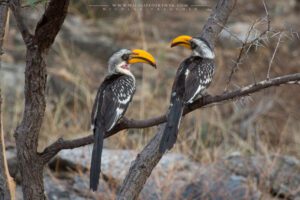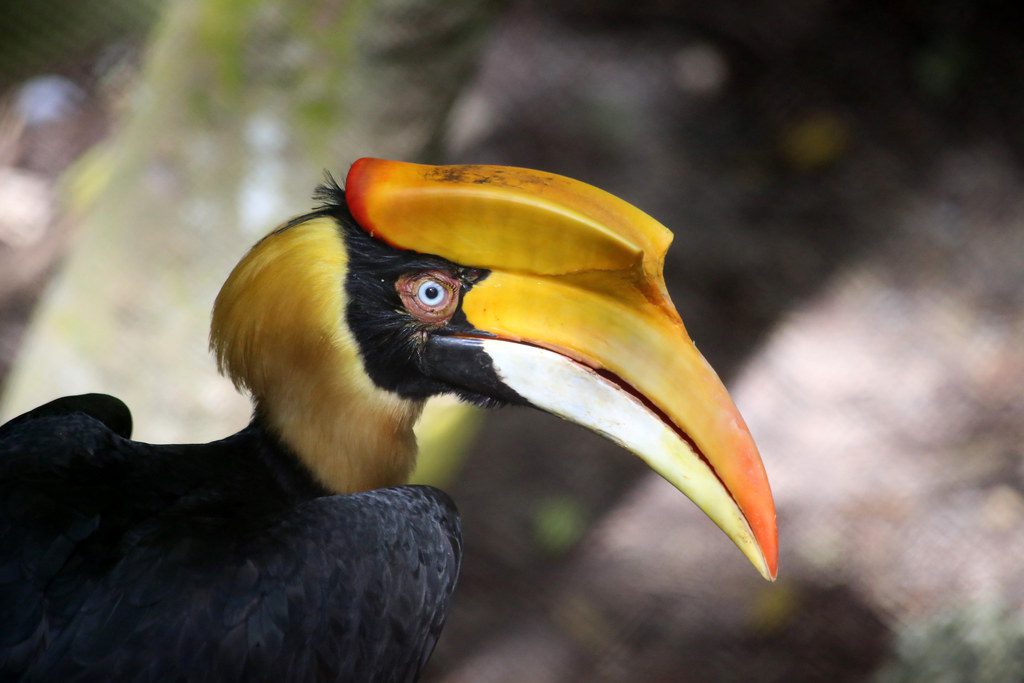Did you know that there are many types of birds we might never see in our lifetime? Among these are the hornbills, some of the most fascinating and unique birds in the world. They are a fascinating group of birds, known for their distinctive beaks and unique behaviors. Here are ten exciting and surprising facts about these remarkable creatures:
Table of Contents
ToggleDiverse Species
- The hornbill family, Bucerotidae, includes a wide variety of species. The great hornbill, found in the forests of India and Southeast Asia, can grow up to 130 centimeters in length, making it one of the largest hornbills.
- In contrast, the red-billed hornbill, native to sub-Saharan Africa, is much smaller, reaching only about 42 centimeters.
Iconic Casques
- The casque’s(french word for helmet) size and shape can be quite dramatic. For example, the helmeted hornbill (Rhinoplax vigil) has a solid casque that is used in head-to-head combat between males.
- This structure varies in size and shape among different species and serves various functions, including making their calls louder, attracting mates, and showing dominance. Isn’t it amazing?
Impressive Beak Mechanics
- The beak of a hornbill is not just for show. It is an essential tool for their survival. They use it to pluck fruits from trees, catch insects, and even break open the hard shells of certain prey items.
- The beak is lightweight but strong, making it perfect for powerful and precise movements.
Unique Nesting Habits
- The female hornbill seals herself inside a tree cavity using mud, droppings, and food items, leaving only a small slit through which the male passes food. This remarkable nesting strategy ensures the safety of the female and her offspring. The male tirelessly brings food to the nest, feeding the female and chicks through the narrow slit.
- Once the chicks are ready to leave the nest, the female breaks out of the sealed cavity, and the family reunites. This method of nesting provides a high level of protection against predators such as snakes and birds of prey. Isn’t it fascinating?
Frugivorous Diet
- Hornbills are considered keystone species in their ecosystems because of their role in seed dispersal. By consuming a variety of fruits, they help maintain the health and diversity of tropical forests.
- Some species, like the great hornbill, are known to travel long distances to find fruiting trees, spreading seeds far and wide and promoting forest regeneration.
Incredible Vocalizations
- Hornbills are known for their loud and varied vocalizations. These calls can be heard over great distances and are used for communication between mates, signaling danger, and establishing territory.
- Each species has its own distinctive call, adding to the rich soundscape of their habitats.
Monogamous Pairs

- Did you know that hornbill pairs don’t just bond for breeding? They also support and cooperate with each other in amazing ways!
- During the nesting period, the male takes on the responsibility of feeding the female and later the chicks, showcasing a high level of parental investment. This cooperative behavior ensures the survival and health of their offspring.
Cultural Significance
- In Borneo, the Dayak people revere the rhinoceros hornbill as the king of birds and a symbol of the spirit of their ancestors.
- In parts of Africa, hornbills are featured in tribal art and are believed to bring rain and fertility. These cultural beliefs highlight the deep connection between hornbills and the communities that share their habitats.
Remarkable Lifespan
- The longevity of hornbills is remarkable compared to other birds of similar size. Their extended lifespan allows them to reproduce multiple times over their lives, contributing to the stability of their populations.
- Understanding their long life cycles is crucial for developing effective conservation plans that ensure their survival for future generations.
Conservation Efforts for Hornbills
- Many hornbill species face significant threats due to habitat loss, hunting, and the illegal wildlife trade. Deforestation and human encroachment are major factors leading to the decline of hornbill populations.
- Conservation efforts are crucial to protect these birds and their habitats, involving local communities, governments, and international organizations.
- Community-based conservation projects in Thailand and Malaysia involve local people in hornbill monitoring and habitat restoration.
Do Read :10 astonishing Elephant facts we never knew ever existed.
Conclusion
I hope reading these fascinating facts about hornbills has given you a deeper appreciation for these remarkable birds. Hornbills are indeed extraordinary birds, not just for their impressive beaks but for their unique behaviors, ecological roles, and cultural significance. Protecting these magnificent birds and their habitats is essential to maintaining the biodiversity and health of the ecosystems they inhabit. By learning more about hornbills and supporting conservation efforts, we can help ensure that these extraordinary birds continue to thrive in the wild.
